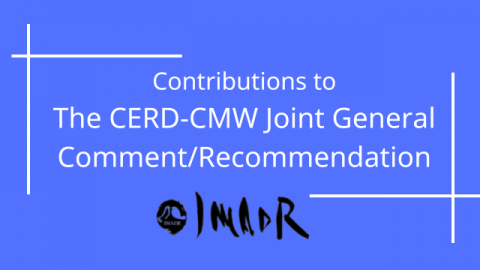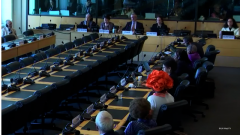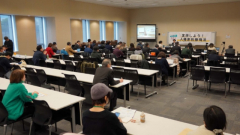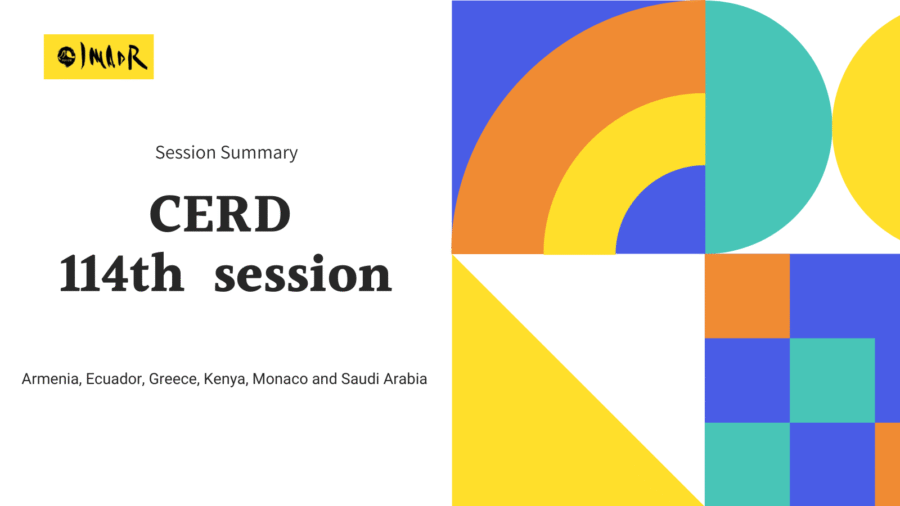IMADR Submitted Contribution to the CERD- CMW Joint General Comment/ Recommendation
April 23, 2024

IMADR submitted inputs for the CERD- CMW Joint General Comment/ Recommendation. Nowadays, society has become more culturally diverse as human mobility becomes more active due to multiple social dimensions such as political, labour, and economic factors. On the other hand, xenophobia has been rising in many societies too, which impacts migrants, their families, and communities in various aspects of life. Therefore, this joint general comment/ recommendation aims to develop authoritative guidance for the State parties on public policies for addressing and eradicating xenophobia and its impacts on the rights of migrants, their families, and other non-citizens affected by racial discrimination.
CONTRIBUTIONS TO THE CERD-CMW JOINT GENERAL COMMENT/RECOMMENDATION ON OBLIGATIONS OF STATE PARTIES ON PUBLIC POLICIES FOR ADDRESSING AND ERADICATING XENOPHOBIA AND ITS IMPACT ON THE RIGHTS OF MIGRANTS, THEIR, FAMILIES, AND THEIR NON-CITIZENS AFFECTED BY RACIAL DISCRIMINATION
29 March 2024
INTRODUCTION
The International Movement Against All Forms of Discrimination and Racism (IMADR) is an international nonprofit, non-government human rights organisation devoted to eliminating all forms of discrimination and racism, forging international solidarity among discriminated groups and advancing the international human rights system. IMADR appreciate that the UN Committee on the Elimination of Racial Discrimination (CERD) offer the opportunity to contribute to the development of the CERD-CMW joint General Comment/Recommendation. Our submission provides inputs, responding to several guided questions.
II. INTERSECTIONALITY
In response to the fifth question concerning intersectionality, the intersectionality lens helps address xenophobia by seeing issues as ones with multiple layers. Xenophobia occurred not only because of their migrant status but also inter alia, gender norms, religion, and ethnicity. In many cases, migrant women are more likely to be discriminated against, especially in a male-centred society. For instance, in Korea, in 2019 the National Basic Livelihood Security System used to be available only to foreigners who have married a Korean citizen (a marriage migrant) if they are pregnant, raising a child or supporting a family member of their Korean Spouse. Moreover, a divorce required marriage migrants to perform gendered roles such as raising a child or taking care of Korean spouses’ families if they desired to keep staying1. Such policy reproduces the power hierarchies between women and men as well as gendered roles. Power hierarchies based on gender are also reflected in the fact that 35 per cent of women in domestic violence shelters were foreign nationals in Iceland2.
Moreover, intersecting forms of discrimination make migrant women of ethnic minorities vulnerable to hate crimes. For example, ethnic Muslim communities continued to occur in a way that they were treated with suspicion by public authorities, which feeds prejudice and negative stereotypes against them. Additionally, the amendment to the Federal Civil Service Act and other laws may discriminate against women of ethnic Muslim groups, restricting their freedom to employment, especially headscarf-wearing women in Germany3.
Furthermore, the rise of hate speech against migrants is happening all over the world. There are increasing cases of hate speech in a digital space, especially targeted to migrants, refugees, and asylum seekers coming from sub-Saharan countries and black Moroccans and the Amazigh4. In a similar vein, Uruguay experienced the rise of racist hate speech and hate crimes including on the Internet and social media on top of the cases of religious intolerance towards people of African descent5 as well as in France where some political leaders made racist remarks on certain ethnic minorities, including Roma, Travellers, persons of African descent and Arab origin, and non-citizen6. These examples are just the tip of the iceberg. People experience hate speech or hate crimes because of their multiple identities.
Therefore, it is necessary to integrate people who experienced racist hate speech from different groups into the policy-making process because xenophobia could be experienced differently, as illustrated above, by gender, race, age, disability, sexual orientation, and among other things. And gender-based discrimination intersects with xenophobia where women from migrant backgrounds are subjected to being discriminated against or being victims of patriarchal society in the receiving country.
III. MEDIA
Referring to the sixth question concerning the role of media, setting up international standards for public statements is needed. Currently, Japan is considerably more ‘tolerant’ of discrimination than international standards, both in the media and in the public sphere, such as politics. Not only are discriminatory and xenophobic statements tolerated, but they are even actively communicated by the leading media and politicians. This helps to spread the misconception that xenophobia is not a bad thing. It is therefore necessary, as a minimum, to introduce international standards for public statements. Moreover, as will be elaborated in the answer to the tenth question, such standards must be determined in consultation with the media to make them more aware of the use of language.
IV. EDUCATION
In relation to the seventh question related to education, shared historical understanding is necessary to realise inclusive societies in the long term. To know where the difference comes from, it is important to understand the history. A woman of third-generation Korean Residents in Japan, who has been advocating for their human rights, mentioned that in terms of Japan, it was of significance to be well aware of the history of perpetration for working together with the ‘majority’. She also stated that she wanted to work together with those who were sincere about their own privilege and saw the issues related to Korean Residents in Japan as a problem for the Japanese people and society. These remarks underline how we can fight against xenophobic attitudes towards migrants or non-citizens, especially those who migrated for historical reasons. Taking that into consideration, it is important to review textbooks and train staff engaging in education to raise awareness of the public about discrimination, privilege, and oppression as well as correct historical backgrounds behind them.
V. CHILDREN AND YOUTH
With regard to the eighth question about child welfare and youth policies, xenophobia could be framed not only as expressed by people but also by the state. Moreover, possible negative impacts on the rights of the children, especially rights to education should be indicated. For example, in Japan, there have been cases over the years where financial subsidies from national and local governments are not disbursed to particular schools that are believed to be associated with a particular state. This not only means that the education of children attending the schools is economically disadvantaged but may also help to increase medium- and long-term divisions and hatred between the citizens of that particular state and Japan.
VI. ADDITIONAL STANDARDS
Responding to the tenth question on additional standards for combatting hate speech, it is crucial to expand its scope of hate speech and introduce normalised indicators on the use of language. Firstly, hate speech should be strongly prohibited by broadening its extent. For instance, Japan’s national act on hate speech, the Act on the Promotion of Efforts to Eliminate Unfair Discriminatory Speech and Behaviour against Persons with countries of Origin other than Japan (2016), is restrictive in its definition of hate speech, limiting the scope of hate speech of the act to that against persons of foreign origin, and imposing no penalties for violations. A stronger stance needs to be taken on all forms of discrimination, including those of xenophobia and against Japanese-born immigrant roots.
Secondly, standardised guidelines on the use of language are necessary. As implied by the word, microaggression, sometimes the use of words has a hand in creating negative images of people of different backgrounds. For example, in Korea, the use of language such as ‘illegal immigrants’ in official documents to mention migrants living without a valid permit might bring negative perceptions towards these migrants7. Likewise, the use of languages such as ‘Western’ and ‘Non-Western’ in laws and policies of Denmark might result in the stigmatisation of those categorised as ‘non-Western’ without any appropriate reasons and in marking a difference between so-called ‘real Danes’ and the ‘others’8.
Moreover, the guidelines on the use of language might be useful to create standardised guidelines for the elimination of hateful comments in the media. For example, in Norway, there was an increasing number of hateful statements against Muslims, people of African descent, Jews, asylum seekers, Sami, and Roma, especially from public authorities and on the Internet. In its concluding observations in 2019, the Committee pointed out that the Strategy to Combat Hate Speech was not fully implemented and that it lacked formal guidelines on which hateful comments to remove from social media platforms9. This could be related to the next question too. The use of digital platforms as a means to spread misinformation or racist incitement comments especially as the election period is coming. Thus, it is crucial to make a guideline on how to identify racist comments and how to remove such comments from such platforms in cooperation with the media.
VII. ELECTION PERIOD
In terms of the eleventh question concerning xenophobic narratives in election processes, a broader scope of xenophobia and standardised guidelines on the use of language is necessary as mentioned above. Additionally, it is necessary to enact a comprehensive anti-discrimination law and ensure that statements made during election campaigning are also covered by legislation. A discriminatory remark by a Japanese lawmaker in the context of migrants was found by a state body to be a violation of human rights, yet neither the political party to which the politician belonged nor the government in which the politician held office took any action against the lawmaker.
VIII. LOCAL GOVERNMENT
With respect to the twelfth question about the role of local government, it is necessary and possible for local government to develop more progressive local ordinances and redress mechanisms than the national law with regard to human rights and hate speech, as some local authorities have already done.
At the national level, the only law that exists on hate speech, the Act on the Promotion of Efforts to Eliminate Unfair Discriminatory Speech and Behaviour against Persons with countries of Origin other than Japan, came into force in June 2016. It is the first legislation that provides national and local governments obligation to act against hate speech. It was a landmark in that the passing of this act has led to the enactment of local ordinances. It has also spread awareness amongst people that hate speech is legally unacceptable.
However, the scope of the act is very narrow as it defines hate speech as “unfair discriminatory speech and behaviour against persons with countries of origin other than Japan” which means “unfair discriminatory speech and behaviour that incites the exclusion of persons who are from countries or regions outside of Japan or the descendants thereof who are legally residing in Japan exclusively from local communities because they are from countries or regions outside of Japan, including that which announces in public that there will be harm to the life, body, liberty, honour or property of persons with countries of origin other than Japan and that which is extremely disparaging to persons with countries of origin other than Japan, to facilitate or induce a discriminatory attitude against them.” Also, the act does not sanction offenders.
On the other hand, some local governments offer more progressive instances. For example, Osaka City’s local ordinance against hate speech is the first ever of its kind and was enacted before the national act. Its definition of hate speech includes not only discriminatory speech against persons with countries of origin outside Japan but also discrimination based on race and ethnicity, regardless of countries of origin while Osaka Prefecture’s ordinance explicitly “prohibits” hate speech, providing that “[n]o one must not express an unfair discriminatory speech based on race or ethnicity”. Also, under the ordinance, the mayor takes necessary measures to prevent such speech from spreading and should publish the name of the person who has done the hate speech, while not directly controlling the content itself of the speech.
Another example is Tokyo, the biggest city in Japan, which also has an ordinance similar to Osaka City’s. It has a broad definition of “unfair discriminatory speech” and was meant to be aligned with the Olympic Charter as the city was in preparation to host the Olympic Games in 2020 (which eventually took place in 2021). Additionally, the Tokyo Bar Association offers model clauses for local ordinances against racial discrimination, which provides a legal basis and model for developing an ordinance banning hate speech with criminal penalties.
A further example is Kawasaki City in Kanagawa Prefecture. Kawasaki City’s ordinance is the only legislation to date in Japan that prohibits hate speech with criminal punishment (punishment of fine up to JPY 500,000). Although punishable hate speech is even narrower than the national act’s definition, it is a good practice that shows the local government can do more than the national act.
While progressive draft ordinances were proposed in some local governments, the content was limited after the deliberation process or the draft ordinance itself was scrapped. This may be due to the current perception by some that discrimination, xenophobia and hate speech are not a problem in Japan or the region, as well as consideration for freedom of speech.
IX. JUSTICE ADMINISTRATION SYSTEM
Engaging with the thirtieth question around the justice administration system, the justice administration system should at least refer to international human rights laws to ensure that internationally established concepts of discrimination and xenophobia and protections from them are properly reflected in the remedies for specific domestic harms. Currently, in Japan, courts are less likely to refer to international human rights law, including treaties ratified by Japan, or to decide whether a case is illegal or lawful on that basis.
- CERD/C/KOR/CO/17-19, paragraph 21.
- CERD/C/ISL/CO/21-23, paragraph 21.
- CERD/C/DEU/CO/23-26, paragraph 35.
- CERD/C/MAR/CO/19-21, paragraph 17.
- CERD/C/URY/CO/24-26, paragraph 21.
- CERD/C/FRA/CO/22-23, paragraph 11.
- CERD/C/KOR/CO/17-19, paragraph 7.
- CERD/C/DNK/CO/22-24, paragraph 10.
- CERD/C/NOR/CO/23-24, paragraph 13 and 14.
▶︎You can download the document: IMADR_CERD CMW Joint General CommentRecommendation – Submissions
▶︎ You can also find our contribution on the OHCHR website.





